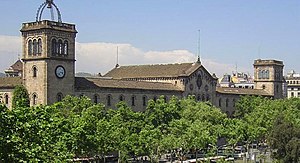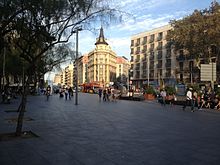Plaça de la Universitat, Barcelona

The Plaça de la Universitat (official Catalan-language name since 1980; Spanish: Plaza de la Universidad) is one of Barcelona's central squares, at the border between the districts of Eixample and Ciutat Vella. It is located at the intersection of Gran Via de les Corts Catalanes, Carrer d'Aribau and Ronda de Sant Antoni. It is also just west of Plaça de Catalunya, to which it is linked by the Ronda de la Universitat and Carrer de Pelai.
The plaza is named for the University of Barcelona, whose neo-Gothic main campus lies on its northwest side. The main University building was built between 1863 and 1889 by the architect Elies Rogent, who also devised the square in 1874,[1][2] at the time when the Eixample was being built after the complete demolition of the city walls. Along with Plaça d'Urquinaona, it is arguably one of the most common gathering-places for demonstrations in the city, as well as offering a pedestrianised area popular with skaters. There square is also surrounded by a number of shops and restaurants, and a primary school.
Transport
Universitat metro station is located on the square and it is served by Barcelona Metro line 1 and line 2.
See also

References
External links
- Universitat de Barcelona.
- v
- t
- e
- Acadèmia
- Alfons X
- André Malraux
- Àngels
- Antoni Maura
- Antoni Pérez i Moya
- Antonio López
- Arts
- Assemblea de Catalunya
- Aureli Capmany
- Bella Dorita
- Botticelli
- Caba
- Can Dragó
- Can Rosés
- Caramelles
- Carbonera
- Cardenal Cicognani
- Carles Buigas
- Cascades
- Catalana
- Catalunya
- Centre
- Cinc d'Oros
- Clota
- Comercial
- Comte de Sert
- Congrés Eucarístic
- Consell de la Vila
- Diamant
- Doctor Letamendi
- Doctor Serrat
- Dubte
- Duc de Medinaceli
- Emili Vendrell
- Espanya
- Estatut
- Europa
- Font Castellana
- Fort Pienc
- Fossar de les Moreres
- Francesc Macià
- Frederic Marès
- Gal·la Placídia
- Gardunya
- Garrigó
- George Orwell
- Glòries
- Goya
- Guinardó
- Herenni
- Heroïnes de Girona
- Hispano-Suiza
- Ildefons Cerdà
- Indians
- Jardins d'Alfàbia
- Jardins d'Elx
- Jaume I
- Jaume II
- Jean Genet
- Joan Amades
- Joan Peiró
- Joanic
- Josep Puig Esteve
- Karl Marx
- Kobe
- La Maquinista
- La Mercè
- Les Corts
- Lesseps
- Llagut
- Llevant
- Mainada
- Mar
- Maragall
- Margarida Xirgu
- Marquès de Foronda
- Martí i Llaurado
- Masadas
- Molina
- Monestir
- Mossèn Clapés
- Nord
- Nou Barris
- Nova
- Olèrdola
- Orfila
- Pablo Neruda
- Països Catalans
- Pedralbes
- Pedró
- Pes de la Palla
- Pi
- Pius XII
- Pla de Palau
- Pau Vila
- Pompeu Gener
- Portal de la Pau
- Prat de la Riba
- Primavera
- Ramon Berenguer el Gran
- Raquel Meller
- Regomir
- Rei
- Reial
- República
- Rom Cremat
- Sant Agustí
- Sant Felip Neri
- Sant Jaume
- Sant Josep de Calassanç
- Sant Just
- Sant Pere
- Sants
- Sol
- Sòllers
- Sortidor
- Taxonera
- Teatre
- Tetuan
- Univers
- Universitat
- Urquinaona
- Verda de la Prosperitat
- Verdaguer
- Vila de Gràcia

41°23′08″N 2°09′51″E / 41.385644°N 2.164048°E / 41.385644; 2.164048











